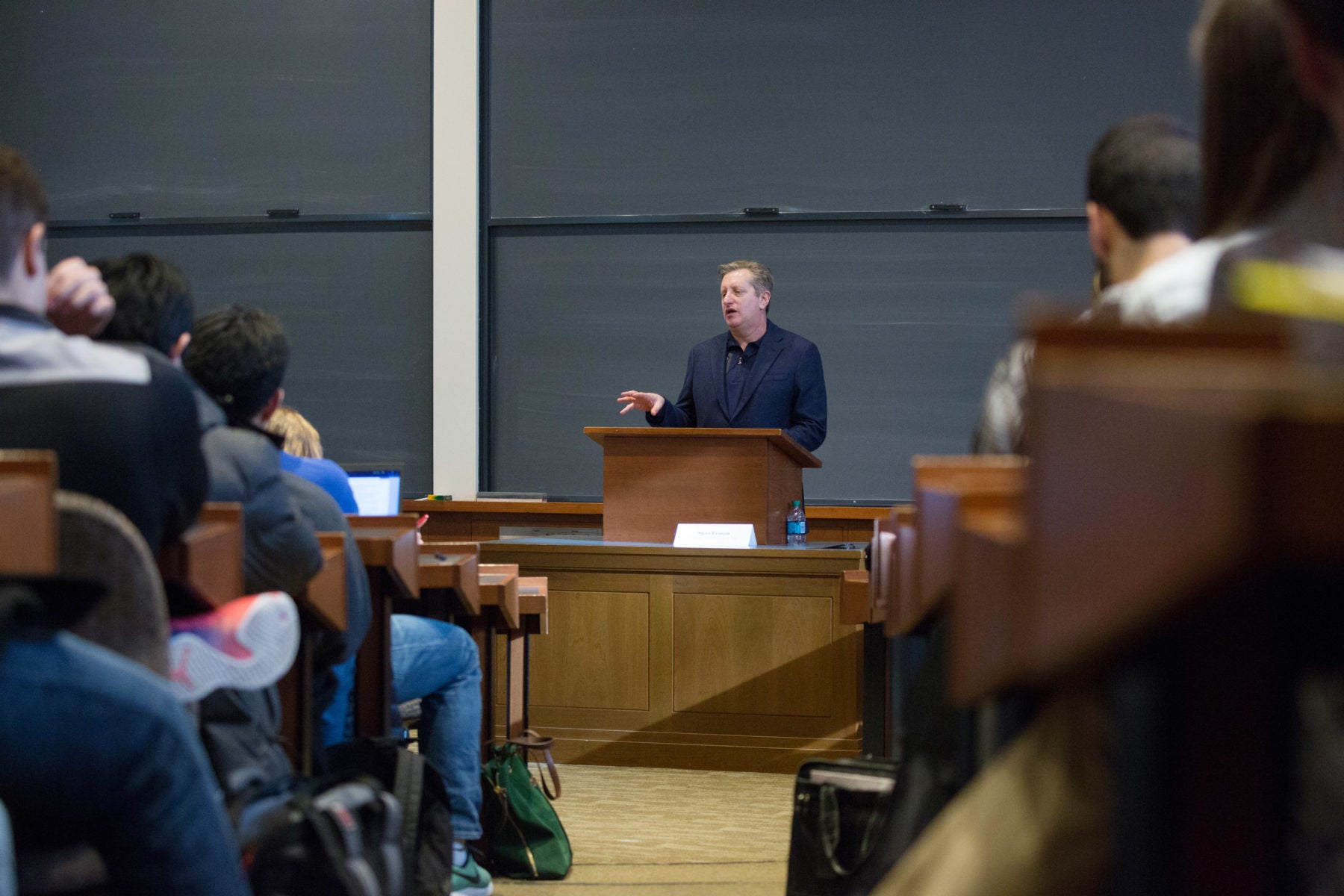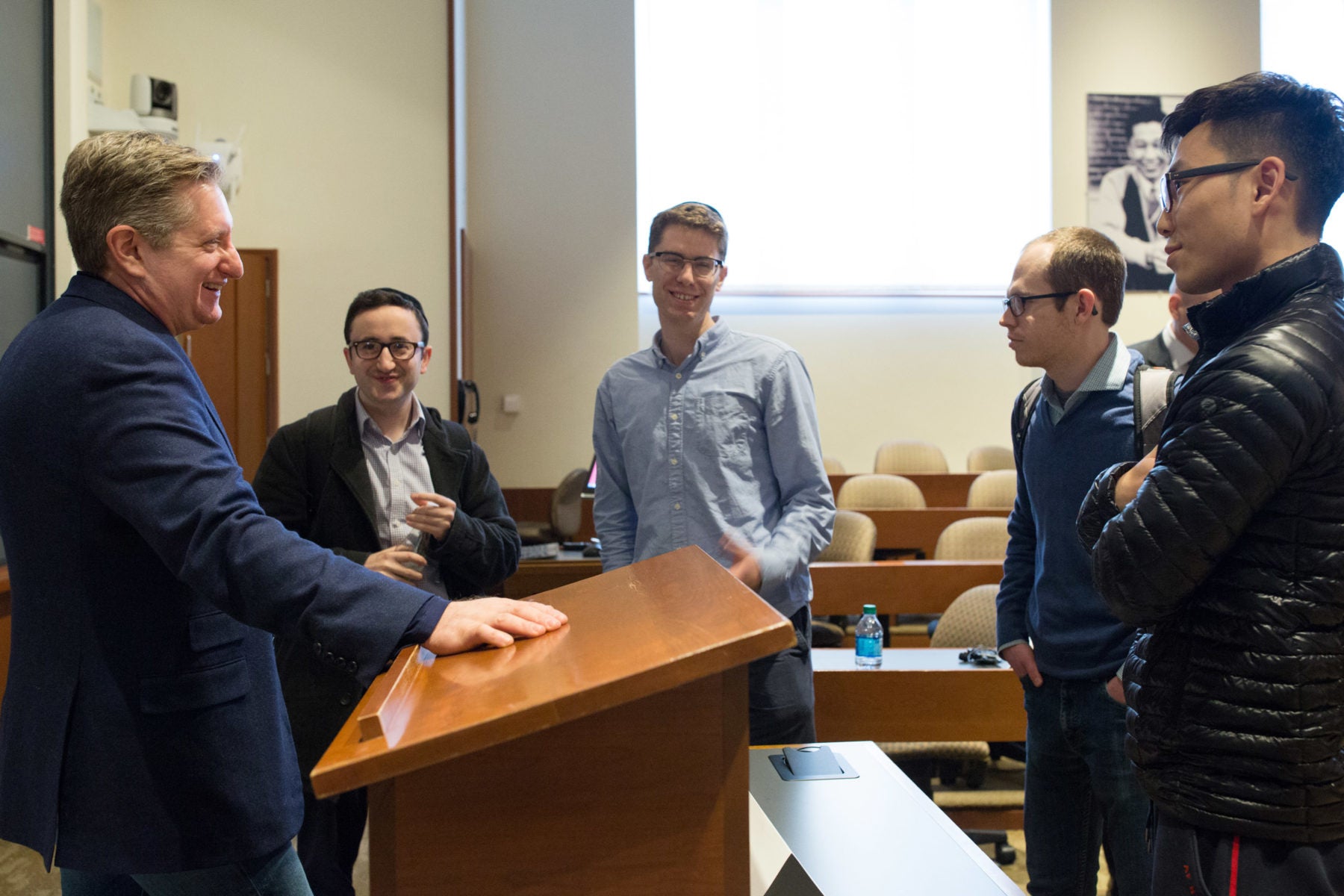Steve Eisman ’88, an investor famed for predicting the 2008 financial crisis, spoke to HLS students in early March about why the economy crashed and whether the administration of President Donald Trump will undo the financial regulations enacted afterward.
In his first visit to campus since he graduated, Eisman lived up to his provocative, contrarian reputation, burnished by the Michael Lewis book “The Big Short” and the film of the same name. The hedge fund investor, whose pre-crash investment strategy was the focus of the book and film, dropped expletives to describe banks’ and lenders’ exploitation of consumers. He declared Alan Greenspan “the worst Federal Reserve chair in history” for failing to take action against subprime lending practices in the 2000s.

Eisman blamed the financial crisis of nine years ago on financial executives’ greed, negligence, and psychological blinders
“Three things need to happen for a financial crisis,” Eisman told about 75 students at a talk introduced by HLS professor Holger Spamann.
“You need way too much leverage, you need a big asset class that blows up, and finally, you need the big firms of the world to actually hold the asset class. Unfortunately for Planet Earth, you had all three.”
Between 1997 and 2007, American banks’ leverage—their ratio of assets to capital on hand—tripled, Eisman said. But the industry’s risk-weighting formula obscured that fact, showing leverage as flat. Rating agencies gave mortgages low risk ratings and didn’t catch a decline in loan-underwriting standards.

“Another aspect to this, which you’re not going to read in any textbook, is very psychological,” said Eisman. Wall Street executives had grown accustomed to making more money every year, he said, because their firms’ leverage was increasing. “They mistook leverage for genius.”
Meanwhile, between 2002 and 2007, the subprime mortgage industry grew, while relaxing its standards more and more to bring in riskier customers. Many lenders stopped requiring proof of income. “By early 2006, the underwriting standards in the United States were, ‘Can you breathe?’” Eisman said.
Most subprime lenders offered introductory “teaser” rates—a low interest rate and low payments for two to three years, then a higher rate and payments. “They knew customers could afford 3 percent, but could not afford 9 percent,” Eisman says. Lenders counted on subprime customers to refinance every few years. Instead, many defaulted.
“People say you’re such a genius—you predicted the financial crisis,” Eisman said. “No, everyone is a product of their experiences.” As an analyst, Eisman had warned in 1997 that the subprime mortgage industry would collapse. The major subprime lenders of the time soon failed—but new lenders emerged around 2002, many with the same leaders as the old companies.
In fall 2006, Eisman, working for the hedge fund FrontPoint Partners, began to short, or bet against, investments in subprime mortgage bonds. By the end of 2007, those bets had caused FrontPoint’s fund to double from $700 million to $1.5 billion, according to Lewis’ book.
The rest of the financial industry was in crisis. “The ball game was over by August 2007,” Eisman said. That month, he and his family took their annual trip to Nantucket. “My wife said, ‘Have you noticed? Where have all the men gone?’ I said, ‘They went back to the Street to watch the end.’”
Eisman, now a fund manager at Neuberger Berman, praised the financial reforms passed in 2010, after the crash. “Dodd-Frank has been an incredible success,” he said. He defended the federal government’s Consumer Financial Protection Bureau, arguing that consumer protection needs to remain separate from the job of regulating banks. (Before the crisis, he argued, bank regulators did neither job well.) Eisman also praised Daniel Tarullo, a Federal Reserve official who has played a key role in guiding bank regulation.
“Daniel Tarullo has had more power over the U.S. banking system than anyone since Alexander Hamilton,” Eisman said. “He has de-levered it, and he has de-risked it.” Thanks to Tarullo, he added, “for the first time in the over 25 years I have covered the financial services sector, I’m not concerned at all about health of the financial system. It’s never been this healthy.”
Trump has talked about changing Dodd-Frank to go easier on the financial industry, but Eisman predicted Senate Democrats would block any such bills with a filibuster.
“The real battle is going to happen when Trump appoints someone to Tarullo’s seat,” Eisman said. Last month, Tarullo submitted his resignation, effective April 5. His replacement “will have a very different orientation,” Eisman predicts. “The Fed regulates the banks through the annual stress test. In 2018, they’re going to be grading on a much easier curve.”
Under a Trump-appointed bank regulator, “leverage is going to go up, and risk is going go back up,” Eisman predicted. “Four years from now, banks will be more profitable, bank stocks will be higher, and we’ll see how much risk is in the system.”
